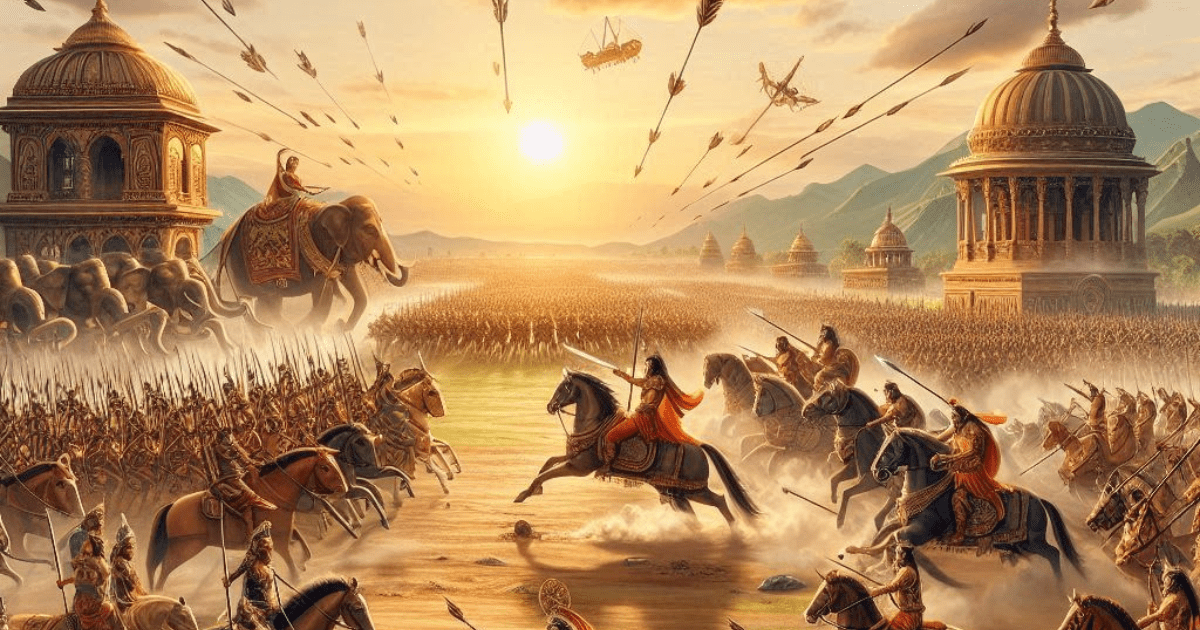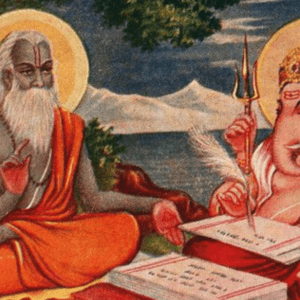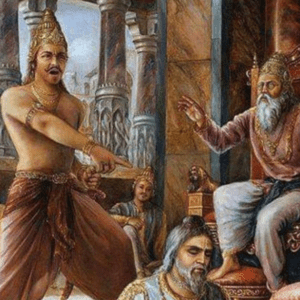Mahabharata is one of the most important and ancient epics in Hinduism. If you are here you might want to know what is Mahabharat. This Sanskrit epic poem is huge, with over 100,000 verses written by sage Vyasa. It tells the story of a great battle between two families, Pandavas and Kauravas, who fight for the throne of Hastinapura.
The Mahabharata is not just a war story; it is also filled with devotional and philosophical reflections on duty and righteousness. It introduces us to great characters like Krishna, Arjuna, Bhishma, and Draupadi.
Mahabharat has greatly influenced Indian culture and history, shaping beliefs and traditions for centuries. Whether interested in mythology, history, or philosophy, the Mahabharata offers a rich and fascinating journey into ancient Indian wisdom.
Table of Contents
The Story of Two Kauravas and Pandavas
Around 400 BCE, the Kuru Dynasty ruled Hastinapur from where two cousin families emerged: Kauravas and Pandavas. The eldest Kaurava, Duryodhana, was driven by jealousy and ambition towards their cousins- the Pandavas.
Pandavas were the right heir to the throne of Hastinapur however, Duryodhan and Kauravas’ jealousy led to his refusal to share the kingdom with the Pandavas. This eventually led to a series of cunning games, politics, deceit, exile, and eventually, war. Kaurava’s pride and misguidance from their uncle Shakuni resulted in the great battle of Kurukshetra where numerous mighty warriors fiercely for power and justice.
When Was Mahabharat Written?
Mahabharata was written over a long period of time. It is difficult to determine the exact date, but many historians, mythologists, and scholars believe that drafting started around 400 BCE and continued until 400 CE. Mahabharat was originally passed down to many generations orally until it was written down into 100,000 verses.
Sage Veda Vyasa is traditionally considered to have authored the Sanskrit Epic Mahabharat that we know about today. It is also believed that since Mahabharat is so vast and complex, it is likely that many poets and scholars contributed to its final form. 100,000 verses in Mahabharat make one of the longest epic poems in the world.
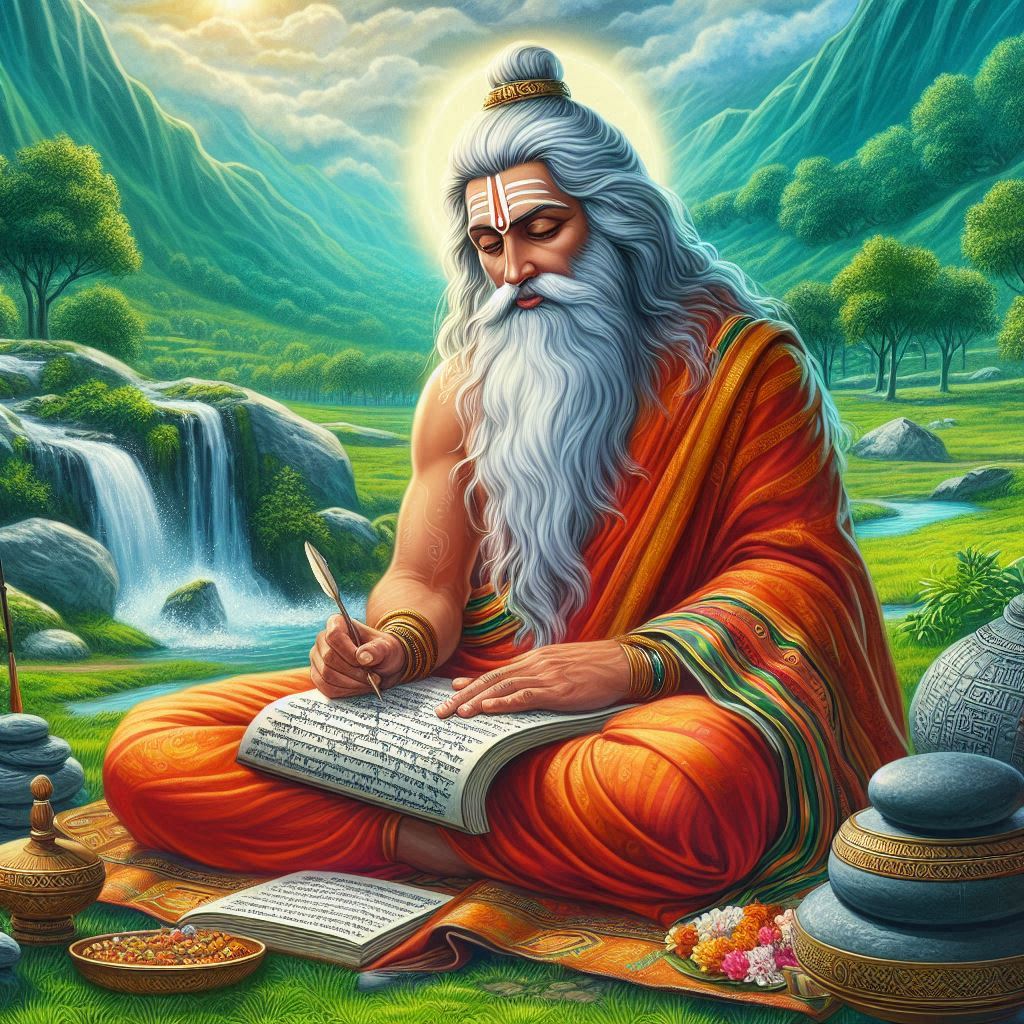
Mahabharat is divided into 18 books, called Parvas; each of these Parvas covers a different aspect of the story. The central narrative is mainly around the conflicts between the Pandavas and the Kauravas. and their battle for the throne of Hastinapura and righteousness.
Also Read: Who Watched Mahabharat 16 Times?
Structure And Composition Of Mahabharat
Mahabharat is divided into 18 Parvas (Books) each containing numerous Adhyayas (Chapters). These chapters chronicle the story of Kurukshetra, its aftermath, and the fates of the Kaurava and Pandava princes. Here is a quick overview of all the Parvas:-
Adi Parva (The Book of the Beginning)
This Parva introduces key characters, setting the scene for their story arc in this epic. It provides the origins of the Kuru dynasty as well as key figures such as Bhishma, Dhritarashtra, Pandu, and the Pandavas being born.
Sabha Parva (The Book of the Assembly Hall)
This section details the construction of Indraprastha Palace as well as the infamous Chaupar game that led to Pandavas’ exile and Draupadi’s insult.
Vana Parva (The Book of the Forest)
It is about when the Pandavas endure 12 years in exile in the forest, where they meet various sages and gain valuable lessons along the way.
Virata Parva (The Book of Virata)
The Pandavas spent their final year of exile living undetected in Virata before finally coming forward at its conclusion to reveal who they were.
Udyoga Parva (The Book of Effort)
This book describes the prewar preparations, including attempts at peace negotiations.
Bhishma Parva (The Book of Bhishma)
The Great Bhagavad Gita in the form of spiritual wisdom was imparted to Arjuna by Krishna in the Bhishma Parva. The war begins, with Bhishma leading the Kaurava army.
Drona Parva (The Book of Drona)
After Bhishma is defeated, Drona takes control. This book features intense battles and Abhimanyu’s tragic untimely demise.
Karna Parva (The Book of Karna)
Karna now becomes the Kaurava forces’ leader, representing both strength and fragility – an axiom for his heroic yet tragic character.
Shalya Parva (The Book of Shalya)
Shalya, a reluctant warrior, takes charge of the Kaurava army as war draws closer to its destructive end.
Sauptika Parva (The Book of the Sleeping Warriors)
This Parva chronicles Ashwatthama’s raid on Pandava soldiers during the night when they were asleep, who were killed by the cowardly act.
Stri Parva (The Book of the Women)
The aftermath of war is depicted, with particular focus on the sorrow and anguish of those left behind – women in particular.
Shanti Parva (The Book of Peace)
Yudhishthira is crowned King while Bhishma provides lessons on statecraft and dharma from his bed of arrows.
Anushasana Parva (The Book of Instructions)
Bhishma continues his discourse on various aspects of duty as well as morality with Dharma.
Ashvamedhika Parva (The Book of the Horse Sacrifice)
Yudhishthira performs the Ashvamedha Yagya to establish his order and acceptance.
Ashramavasika Parva (The Book of the Hermitage)
Dhritarashtra, Gandhari, Kunti, and Vidura goes into exile.
Mausala Parva (The Book of the Clubs)
The Yadava dynasty faces destruction due to internal conflicts.
Mahaprasthanika Parva (The Book of the Great Journey)
The Pandavas forsake their kingdom and start their journey to the beyond, their final journey into the Himalayas.
Svargarohanika Parva (The Book of the Ascent to Heaven)
The final parva describes the ascent of the Pandavas and their fate in the afterlife.
Major Character In Mahabharat
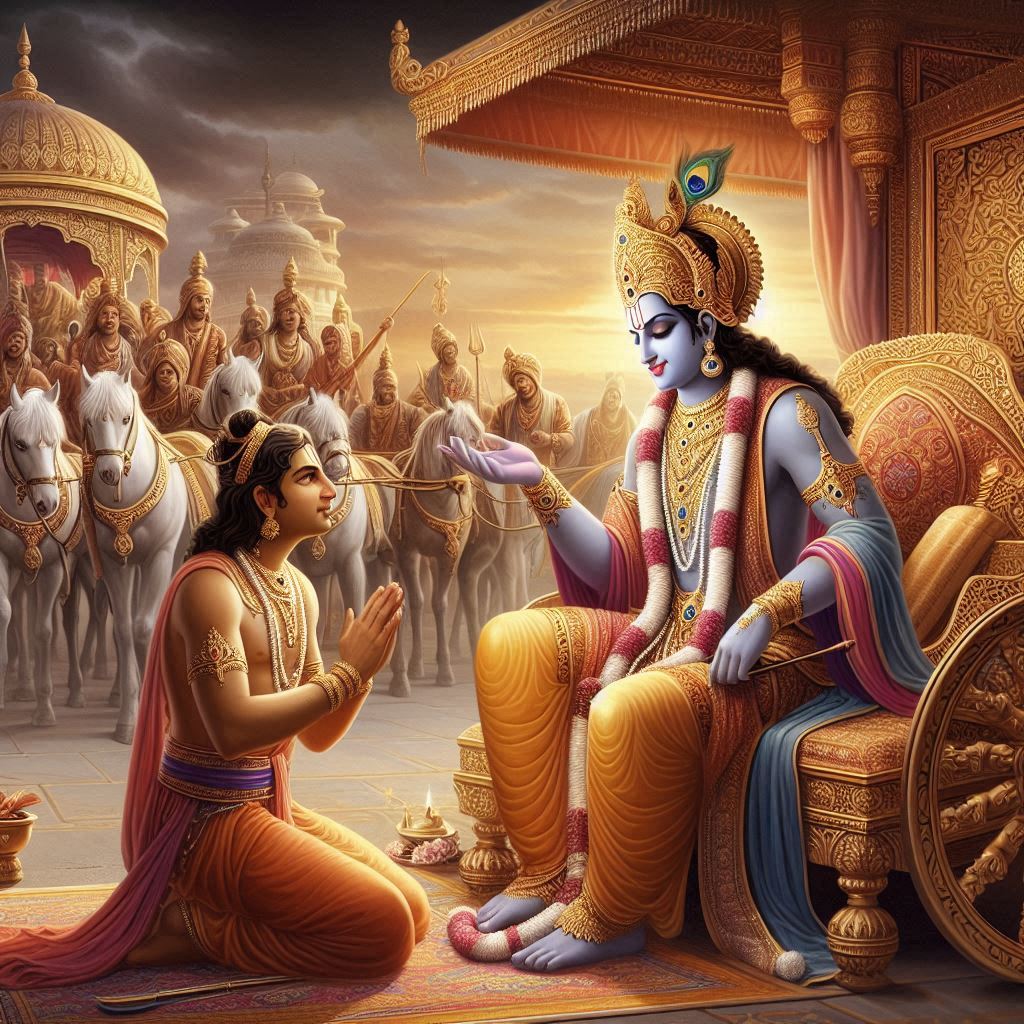
Numerous characters in the Mahabharat play a vital role, the major characters in Mahabharat include:
- Pandavas: Yudhishthira, Bhima, Arjuna, Nakula and Sahadeva were five brothers known collectively as the Pandavas (because of their Father- Pandu). Yudhishthira was known for his commitment to truth; Bhima for his strength; and Arjuna for his archery skills and archery abilities while Nakula and Sahadeva excelled at swordsmanship as well as wisdom
- Duryodhana: Duryodhana leads his 100 brothers as the main antagonist, driven by ambition and jealousy. He along with his brothers is mentored by his maternal uncle Shakuni
- Krishna: According to Hindu text Krishna is considered an incarnation of Lord Krishna. Krishna serves as both a friend, guide and divine embodiment. He gives Arjuna the Bhagavad Gita as part of their lessons in self-improvement and
- Draupadi: Draupadi was known for her beauty and strong will; her presence played a pivotal part in their story. She was the daughter of King Drupada and wife to all the 5 Pandavas
- Bhishma: The granduncle of both Pandava and the Kauravas with a vow of celibacy. He was a great warrior and a wise administrator who had to make many sacrifices in his life
- Drona: One of the greatest coaches, teacher as well as a warrior who fought for the Kauravas
- Shakuni: Shakuni is the maternal uncle of the Kauravas who masterminds the game of dice known as the “Chaupar” and catalyzes the rivalry between the Pandavas and the Kauravas
Events In Mahabharat That Make It Important In Sanatan
One of the defining events is the Kurukshetra War, an epic clash between Pandavas and Kauravas that symbolizes the struggle of good to win over evil. The Kurukshetra War lasted for 18 days during which the greatest warriors and powers of the Bharat fought fierce battles and made amazingly complex strategies to defeat their ops. The Kurukshetra War highlights both righteousness (Dharma) and its consequences (Adharma).
| Day | Leader | Key Events |
|---|---|---|
| Day 1-10 | Bhishma | Beginning of the war, Bhishma’s might, Bhagavad Gita |
| Day 11-15 | Drona | Drona’s strategies, Abhimanyu’s demise |
| Day 16-17 | Karna | Karna’s leadership, battle with Arjuna |
| Day 18 | Shalya | Shalya’s reluctant command, Duryodhana’s defeat |
The Game of Dice is another pivotal moment. Here, the Pandavas are tricked by Shakuni into losing against Kauravas in a fraudulent dice game and exiled. This event presents themes of deceit, honor, greed and pride and the consequences thereof.
The Exile Of Pandavas from the Hasitanapur is a major event that eventually led to a war. The exile of Pandavas shows their strength, wisdom, and perseverance through numerous hardships despite living under constant duress. They were strengthened physically by Dharma and spiritually by Krishna as a result – strengthening themselves for battle in preparation for its ultimate showdown.
The Bhagavad Gita, delivered by Krishna to Arjuna in the Kurukshetra is one of the cornerstones of Hinduism and Sanatan. Here, Krishna shares divine wisdom on duty, righteousness, and reality while answering Arjuna’s fundamental questions about life and reality.
Conclusion
The Mahabharat, Sanskrit’s great 100,000 verses poem is more than just a war story. It depicts the mythology, philosophy, and stories of iconic characters such as Krishna, Pandavas and the Kauravas. It teaches the path of duty and justice and stands as one of the most monumental and ancient epics in Hinduism. Mahabharat is a vast Sanskrit poem, authored by the sage Vyasa, chronicling the epic battle between the Pandavas and Kauravas for the throne of Hastinapura.
If you found this information helpful, do check the rest of our library for more insights about Mahabharat! And don’t forget to share it with others.
